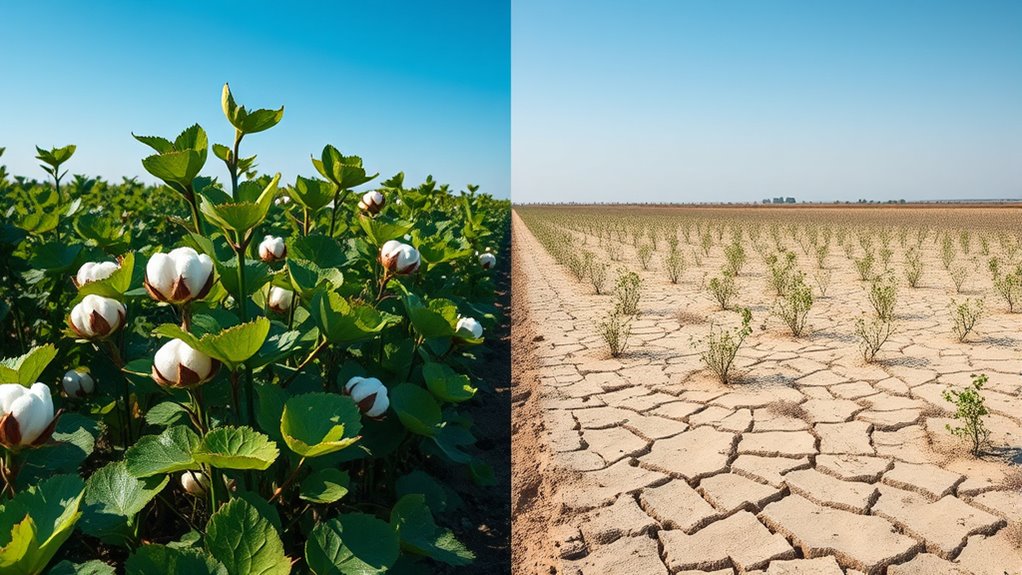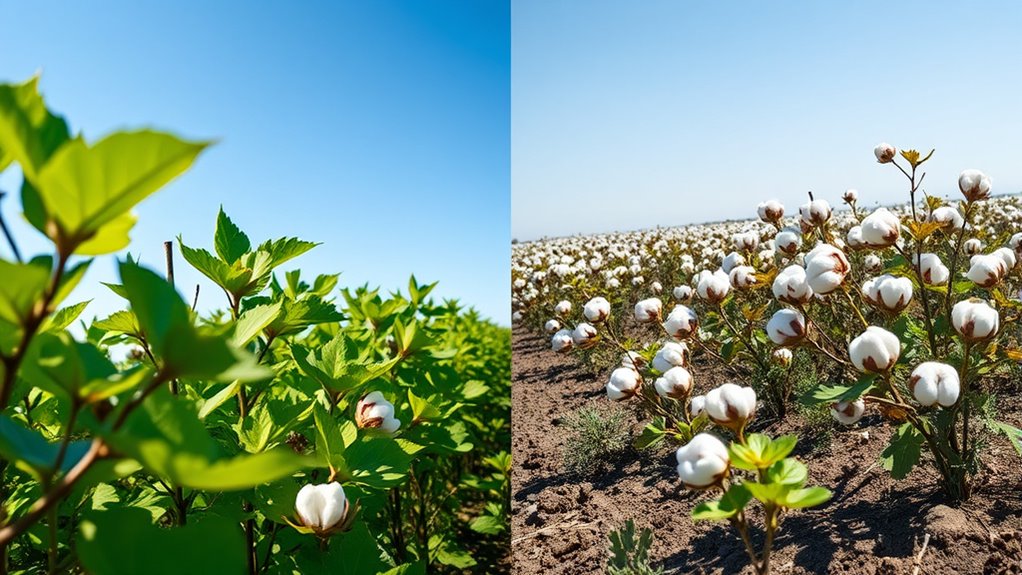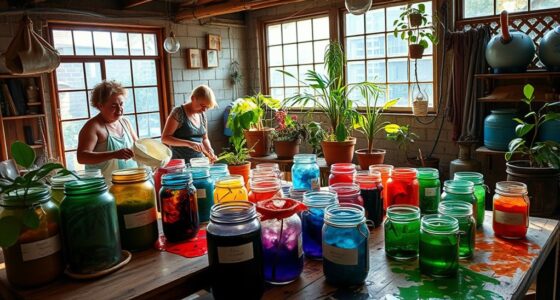When choosing between organic and conventional cotton, you should know that organic avoids harmful chemicals, reduces environmental impact, and promotes healthier soil and water. It’s also better for your skin and communities, with less exposure to pesticides. Conventional cotton might be cheaper and produce higher yields, but it often uses damaging chemicals and consumes more resources. Want to uncover the full truth behind these differences and how they impact your choices? Keep exploring to learn more.
Key Takeaways
- Organic cotton avoids harmful chemicals, reducing health risks for farmers and consumers compared to conventional cotton’s chemical reliance.
- It promotes sustainable farming practices, preserving soil health and lowering environmental impact versus conventional methods.
- Organic cotton uses less water and energy, helping conserve natural resources, unlike the resource-intensive conventional cotton.
- Conventional cotton yields higher quantities at lower costs but causes soil depletion, pollution, and increased greenhouse gas emissions.
- Brands often omit the long-term ecological and health benefits of organic cotton, emphasizing affordability over sustainability.

When choosing between organic cotton and conventional cotton, understanding their differences can help you make more informed decisions. One of the most significant factors is how each type is produced, especially regarding sustainable farming practices and chemical usage. Organic cotton is cultivated without synthetic pesticides, herbicides, or fertilizers, which means it relies on sustainable farming methods like crop rotation and composting to maintain soil health. This approach reduces environmental impact and minimizes chemical runoff that can harm ecosystems. On the other hand, conventional cotton often involves intensive chemical usage, with farmers applying pesticides and synthetic fertilizers to maximize yields. These chemicals can leach into the soil and water, contributing to pollution and harming wildlife.
Choosing organic cotton supports sustainable farming because it promotes soil fertility and biodiversity. Farmers practicing organic methods tend to focus on long-term land health rather than short-term profits. This approach results in less soil degradation and a lower carbon footprint, making it a more environmentally friendly option. Conventional cotton farming, however, depends heavily on chemical inputs that can lead to soil depletion over time and increase the risk of pests developing resistance. The widespread use of chemicals in conventional agriculture also raises concerns about worker safety and the health of nearby communities.
Organic cotton promotes soil health and biodiversity, reducing environmental impact compared to chemical-dependent conventional farming.
When you opt for organic cotton, you’re supporting farming practices that prioritize the environment and human health. Organic farms often avoid genetically modified organisms (GMOs) and synthetic chemicals, reducing exposure to potentially harmful substances. This not only benefits farmers but also ensures that the final product is free from chemical residues, which can be particularly important for sensitive skin or for children. Conversely, conventional cotton may contain traces of pesticides and herbicides, even after processing, which some consumers prefer to avoid.
Moreover, the environmental benefits of organic cotton extend beyond chemical usage. It typically requires less water and energy because it relies on natural processes rather than synthetic inputs. This conservation effort aligns with sustainable farming principles, aiming to reduce the ecological footprint of textile production. In contrast, conventional cotton farming is often resource-intensive, contributing to water scarcity and higher greenhouse gas emissions. Additionally, the adoption of innovative techniques in organic farming can further enhance sustainability by improving yield quality while maintaining eco-friendly practices.
Ultimately, understanding the differences in sustainable farming and chemical usage helps you see why organic cotton is often regarded as a more eco-conscious choice. It supports a healthier environment, promotes sustainable land management, and reduces exposure to harmful chemicals. While conventional cotton might offer cheaper prices and higher yields, the hidden costs to ecosystems and human health are significant. By choosing organic, you’re making a conscious decision to prioritize sustainability and safety in your clothing choices.
Frequently Asked Questions
How Does Organic Cotton Impact Local Farming Communities?
You might not realize it, but choosing organic cotton can positively impact local farming communities. By supporting fair trade practices, you’re helping guarantee farmers earn fair wages and work under better conditions. Organic farming often uses land more sustainably, reducing harmful chemicals and preserving land use. This means communities can thrive without damaging their environment, fostering long-term growth and stability for farmers and their families.
Are There Hidden Costs Associated With Organic Cotton Production?
While it’s tempting to focus only on the benefits, you should consider the potential hidden costs of organic cotton. A thorough cost analysis reveals that organic farming may involve higher production expenses and sometimes lower yields, which could affect pricing. Additionally, the environmental impact, though generally positive, might include challenges like increased land use or resource demands. Being aware of these factors helps you make more informed, conscious choices.
What Certifications Ensure True Organic Cotton Authenticity?
You want to know what certifications guarantee true organic cotton authenticity. Look for certification standards like GOTS (Global Organic Textile Standard) and Oeko-Tex Standard 100, which guarantee strict authenticity verification. These certifications confirm that the cotton meets rigorous environmental and social criteria, giving you confidence in its organic status. Always check for reputable, recognized labels on products to ensure you’re getting genuinely certified organic cotton.
How Does Organic Cotton Affect Global Water Resources?
You might not realize, but choosing organic cotton helps reduce your water footprint and prevent aquifer depletion. Organic farming uses fewer chemicals and relies more on rainwater, conserving groundwater sources. Unlike conventional cotton, which often depletes aquifers through intensive irrigation, organic cotton supports healthier water cycles. By opting for organic, you’re contributing to the preservation of essential water resources and promoting sustainable agriculture practices worldwide.
Can Organic Cotton Be More Sustainable Long-Term Than Conventional?
You might wonder if organic cotton is more sustainable long-term than conventional. It can be, because organic farming focuses on improving soil health through crop rotation, which helps prevent soil degradation. This approach reduces the need for chemical inputs and promotes biodiversity. Over time, healthier soil supports resilient crops and lowers environmental impact, making organic cotton a better choice for long-term sustainability compared to conventional methods.
Conclusion
Choosing organic cotton supports sustainable farming, but did you know that organic fields can require up to 91% more land than conventional ones? While organic options often seem better for the environment and your health, understanding these nuances helps you make smarter choices. Ultimately, being informed lets you align your shopping habits with your values, ensuring you contribute to a more sustainable future, one fabric at a time.









